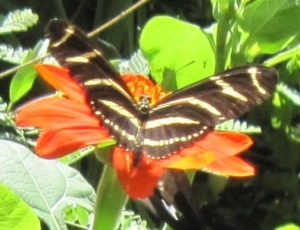
Zebra Long Wing Butterfly
(Heliconius charithonia)
Photograph by Nancy E. Rogers
Why Previews Are Valuable
Introduction
One of my readers previewing my forthcoming second novel, H’Ilgraith: Sister of the House of H’Aleth (estimated release date January 2020), identified a misconception which I had written into the story. Here are her comments:
“… I am enjoying reading it … but I have to tell you now about something written that is driving me ‘mad’. On page 43 you use butterfly metamorphosis in an explanation. As all of America, in fact the whole world, Eric Carle has influenced you. His caterpillar spins a cocoon, then becomes a butterfly. For two thirds of my 33 year teaching career I had the “Hands On Science” kit on butterflies. Every year I tried to get my students to look closely, take daily notes and make drawings while watching the life cycle of the Painted Lady, Vanessa cardui. Despite the fact that each caterpillar crawled to the top of the container, hung upside down, and performed its last molt—split its last caterpillar exoskeleton— to reveal a shell chrysalis, many of my students insisted that the caterpillar spun a cocoon. While butterflies do have a spinning ability, the majority do not spin a cocoon (I can’t find one on an internet search). Most moths spin cocoons before their last molt. I will get off my soapbox with a final plea for you to remove ‘spins a cocoon’ when referring to butterfly metamorphosis.”
Of Butterflies and Moths
This turned out to be a most informative exercise for both of us. Different insects undergo metamorphosis in different ways. Even butterflies and moths have a different “spin” on the process of metamorphosis.
First, we had to sort out the two categories of insect metamorphosis. In complete metamorphosis (holometabolous), there are four stages of development – egg, larva, pupa, and adult. For both moths and butterflies, the caterpillar is the larval form. During the pupa stage, the structure of the caterpillar is completely broken down and remade into a totally different form. With incomplete metamorphosis (hemimetabolous), there are three stages– egg, nymph (similar to larva), and adult. There is no pupa stage. The insect has and keeps the same basic shape of the adult while it develops additional features possessed by the adult (e.g., reproductive capability and wings).
Then we had to sort out whether or not caterpillars have an exoskeleton. Typically, exoskeletons are hard, rigid “coats” or “shells” that protect the insect’s main body while leaving its legs and antennae free to move. As an insect grows and becomes larger, it must shed (molt) its exoskeleton and develop a new one that will accommodate a larger body size. A caterpillar, however, has a soft, flexible body; yet, it still has an exoskeleton – one that is soft and flexible. Resilin is a substance that provides flexibility in the exoskeleton of insects and allows them to be mobile (Michels, et al., 2016). Chitin is another constituent of the exoskeleton (Merzendorfer & Zimoch, 2003). It contains calcium carbonate which hardens it. Insects with “soft” exoskeletons – such as caterpillars – have much less chitin than those with hard exoskeletons. Nevertheless, a caterpillar’s exoskeleton is not elastic; so the caterpillar must still molt.
When the caterpillar (the larva stage) sheds its exoskeleton for the last time, it has entered the pupa stage. Just before their last molt, moth caterpillars spin a tough, silk cocoon; then molt inside their cocoon, allowing the exoskeleton to provide additional protection. Butterfly caterpillars form a strong, solid cover – a chrysalis – around their body which is revealed after their last molt. Thus, a chrysalis shields a butterfly caterpillar while a cocoon shields a moth caterpillar. During the pupa stage, the body of the caterpillar – whether a butterfly or a moth – is broken down, and the adult form of the insect is created.
Outcome
I revised the description of butterfly metamorphosis in the novel to reflect changes that occur specifically in butterfly caterpillars. Future readers of the novel may be relieved to know that I did not include any mention of holometabolous or hemimetabolous metamorphosis.
References
Merzendorfer, H., and Zimoch, L. (2003.) Chitin metabolism in insects: structure, function and regulation of chitin synthases and chitinases. J Experimental Biol, 206: 4393- 4412. doi: 10.1242/jeb.00709.
Michels, J., Appel, E., & Gorb, S. N. (2016). Functional diversity of resilin in Arthropoda. Beilstein J Nanotechnology, 7, 1241–1259. doi:10.3762/bjnano.7.115